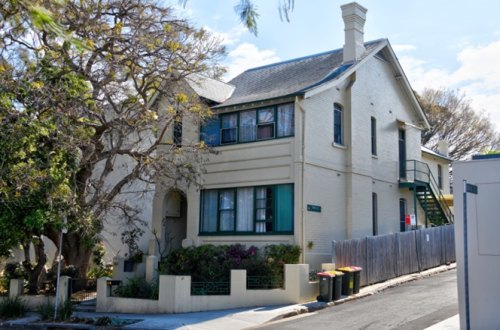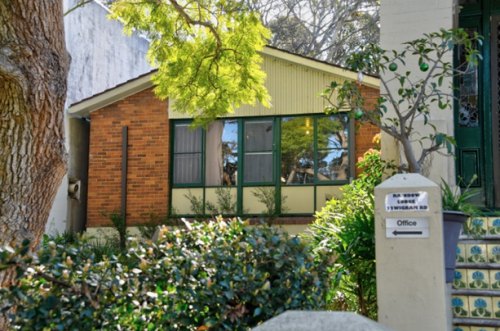The Rainbow Lodge Program was established in 1964 to provide supported accommodation for men on their release from NSW correctional facilities. It was located initially at Bass Hill but re-located to Dulwich Hill before moving to Glebe in 1971. The Rainbow Lodge Program and its inspiration, Judge Rainbow, were at the forefront of a radical change in our approach to breaking the re-offending cycle. For the first half of the 20th century, the dominant view was that the prison sentence should serve as a deterrent to anti-social behaviour (and for those who didn’t get the message, perhaps next time…). The Prisoners’ Aid Association and other not-for-profit groups attempted to ease ex-offenders’ transition into the community, but the Rainbow Lodge Program was the first intensive, residential-based program in Australia designed to actively help parolees re-integrate into the community.
The Rainbow Lodge Program provides parolees with a home for three months, subject to their full participation in its Program. The Program has evolved over almost 50 years as it gained more experience and accumulated more evidence on the most effective ways to foster social re-engagement. Today the Program includes a range of activities designed to build pro-social behaviour and give its participants the skills and confidence to live in the community, as well as individual case management and specialised services to meet each participant’s needs. The Rainbow Lodge Program also provides outreach support for participants when they move into the community. To help equip participants for that move, the Program also operates, as far as possible, with a code of acceptable and expected behaviour, which includes, as for any large household, the expectation that everyone will help with household chores such as cooking.
The Rainbow Lodge Program video explains more clearly than I can, the challenges faced by Program participants, and the commitment of its case managers and staff. The remainder of this article focuses on the innovative history of the Program, and its current situation.1

A Social Innovator
Judge Alfred Rainbow, after whom the Program is named, was admitted to the NSW Bar in 1923 and worked initially in private practice. In 1946 he was appointed Judge in the NSW Workers’ Compensation Commission, a position he held until his death in December 1963, aged 63. Rainbow’s professional obituary described him as a ‘colourful, forthright and fearless’ man with a keen interest in the criminal justice system, and especially in prison reform and the ‘rehabilitation of prisoners’.2 Rainbow was a long-standing President of the Prisoners’ Aid Association, was instrumental in the formation of the Australian Prison After-Care Council and became the inaugural President of its successor, the Australian Crime Prevention Council, in the early 1960s. In life, Rainbow did much to raise public awareness of the benefits of rehabilitation for both ex-prisoners and the community – one posthumous account described Rainbow as a ‘crusader’ for the cause of rehabilitation. Drawing on overseas evidence, Rainbow also increasingly advocated residential programs where the scope for intensive guidance and support gave the greatest chance of success. 3 Rainbow did not live to see his views put into practice in Australia, but his death provided the inspiration and the impetus to establish the Rainbow Lodge Program.

The Judge Rainbow Memorial Appeal, chaired by Justice McClemens, was launched in 1964. It attracted widespread support from organisations (including the Kirby Foundation, the Rotary Club and Fairfield Council) and individuals. Members of the legal profession have been prominent supporters and filled positions on the Board of Management of the Appeal’s administering body, The Judge Rainbow Memorial Fund. Construction of the first Rainbow Lodge Program men’s facility began immediately, with its 18 places expected to be ready by the end of 1964; construction of a women’s facility started soon after.4 The mid-1960s must have been heady days for those who shared Rainbow’s views. But this type of social innovation is expensive to establish and operate. It took time to build evidence of the value of an intensive residential program and make an effective case for government support. In the interim, the Program’s women’s facility was closed, and the scale of its men’s facility was reduced with the move to Glebe in 1971. Soon after though, the Rainbow Lodge Program began to attract government support, with funding for an administrator and a consultant psychologist by the mid-1970s.5
The Rainbow Lodge Program today
The success of the Rainbow Lodge Program’s approach is now widely acknowledged.6 The Program has places for eight men, with three of those places reserved for men who identify as an Aboriginal or Torres Strait Islander. The Program is almost always fully occupied, particularly now it establishes contact with successful applicants prior to their release from prison to ensure, among other things, that they understand the Program’s terms and conditions. The Program’s operation is now mostly funded by the government – primarily through Corrective Services NSW, with the NSW Family and Community Service (FACS) providing a smaller proportion. As a condition of this funding, The Rainbow Lodge Program takes men evaluated as having a high risk of re-offending, complex needs and who would otherwise be homeless. This profile raises additional challenges because, for some, the three-month residential limit is too short. To address this, the Rainbow Lodge Program has drawn on donations to ramp-up its outreach service. It now provides more intensive support to its participants re-settling in the community for a period of up to two years.7
The Rainbow Lodge Program’s greatest current challenge is to organise secure homes for its graduates to re-settle in the community. Private rentals are now out of reach and social housing for singles is in short supply. This leaves traditional boarding houses or couch-surfing, both of which are classed as forms of homeless accommodation by the Australian Bureau of Statistics, because they provide inadequate security of tenure, privacy and scope for a normal social life. The causal relationship between homelessness and re-offending is difficult to identify statistically but there is almost universal agreement that access to a secure affordable home is an important pre-requisite to ex-offenders’ full re-integration in the community.8
But, to end on good news: The Rainbow Lodge Program has begun to build strong relationships with new Community Housing Providers (CHP).9 It currently supports 17 of its residential Program graduates in CHP homes for a period of up to two years, after which this housing will become available for other residents. The Rainbow Lodge Program still cannot ensure a home for all its graduates, but it has strong hopes that its number of CHP places will increase in the future.
The Glebe Society’s kitchen starter packs will help equip Program participants who move into their CHP and social housing homes. At least as important, our packs demonstrate community support for these men as they work to re-build their lives.









One comment. Please add yours.
God Bless Judge Alfred Rainbow